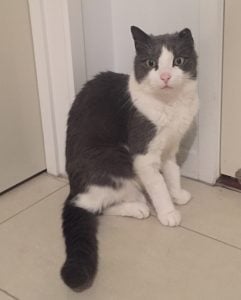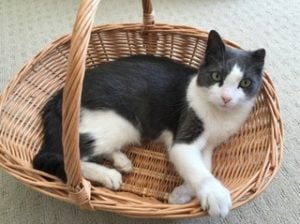Hyperthyroidism is a hormonal imbalance that affects many older cats. There are a few different ways that it can develop, but the end result is that there is too much thyroid hormone being produced causing the cat’s metabolism to go into overdrive.
What are the signs associated with hyperthyroidism?
- increased appetite – many cats are ravenous, even when they’re eating a seemingly large amount of food
- weight loss
- change in behaviour: more restless, skittish and / or anxious
- racing heart rate
- poor coat condition
- increased water intake
- vomiting
- diarrhoea
- weakness
- occasionally difficulty breathing
So, is it really such a big deal if your cat’s on the skinny side and a little jumpy?
Yes, it really is! If you know anyone who has a thyroid issue, they can tell you what a huge influence it has on their general well being. When there is an over-production of thyroid hormone it affects the whole body, all the organ systems as well as mental health – put simply, it’s as though the cat is always switched ‘on’ with ‘all systems go’ 24/7! This can put extra strain on heart and kidney function and if they already have heart or kidney problems, this condition can cause further deterioration.
How is hyperthyroidism diagnosed?
Your vet will do a clinical exam and then run some blood tests. Occasionally additional tests are necessary, but she will discuss those with you at the time.
Can hyperthyroidism be treated?
Yes, there are a few different options:
- Medication – daily medications aim to manage the disease by reducing the amount of thyroid hormone the thyroid gland produces. It’s life-long and there can sometimes be side effects associated with the medications.
- Radioactive Iodine Therapy – this is an in-hospital treatment where a very specific amount of radioactive iodine is given in an injection, travels to the gland and kills off the abnormal thyroid tissue. This therapy can only be given in a hospital where they have special facilities to manage radio-active treatments and requires the cat to stay in hospital for several days. However, once they have successfully completed the treatment, the patient usually does not require any further medications to treat their hyperthyroidism.
- Surgery – this removes the overactive tissue but because of the location of the thyroid, there is always a risk of damage to other tissues nearby including the parathyroid glands which are involved in calcium balance and are not related to thyroid function, despite the similarity in names.
- Low Iodine Diet – this new prescription diet option is now available. The diet is specially formulated for reducing the amount of thyroid hormone produced by the overactive thyroid gland. Despite this sounding like a very simple option, it can be difficult to implement practically since one has to ensure that the cat does not receive ANY other food at all i.e. no drinks of milk, no snacks or snippets of roast chicken, no lizard-catching etc.
The best option for you and your cat is the one which is going to provide the most reliable control of the thyroid hormone production. Discuss all the options with your vet and ask as many questions as you need to, to come up with a suitable plan.
Little Harry – from “skinny and jumpy” to “relaxed and svelte”
Harry is an older cat who had become a voracious eater but was still losing weight. Personality wise, he was still a friendly chap, but his owner had noticed he’d become more restless and sometimes agitated. At his clinical exam he was on the skinny side, had a racing heart rate, and the small area on the front of his neck (where the thyroid gland is located) was slightly swollen. Blood test results showed that he had very high levels of thyroid hormone. Harry was diagnosed with Hyperthyroidism.
Harry started on the oral medication and at first responded very well – he’d put on weight and had started showing some more relaxed behaviours. However, about 3 weeks later he suddenly started getting an upset tummy causing some vomiting and diarrhoea. After ruling out other causes of his upset tummy, it was decided to stop the thyroid medication since he appeared to be suffering from some of the side effects which can sometimes occur in some patients. After discussing different options for Harry, we decided that the radio-active iodine treatment would give him the best long-term prognosis. He was referred to Brisbane Veterinary Specialist Centre in Albany Creek, where he underwent the treatment and monitoring and went home happily after his hospital stay.
A couple of months on, Mr Harry is going really well. He’s eating like a normal kitty now, instead of like a ravenous lion; sleeps and relaxes contentedly; has put on some weight and looks svelte rather than skinny; enjoys spending time with his owner and his many “Harry Fans/Friends”.
If you think your cat may be suffering from hyperthyroidism or you think he/she just needs a good check-up, give us a call on 0481 527 678 or email – we’ll be happy to help!


